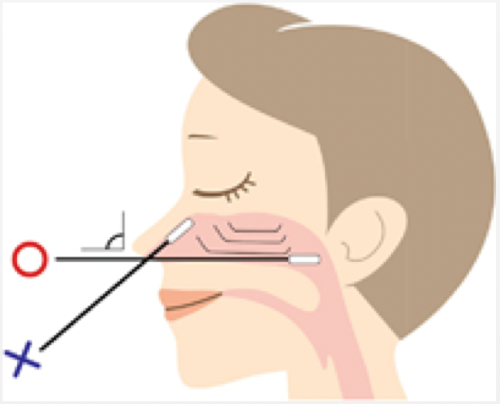HINT: How to promote comfort and safely perform a nasopharyngeal (NP) swab on children and youth
Connected Care Quick Hits are up to date and evidence based recommendations for the care of children with medical complexity & technology dependence, from hospital to home.
HINT: How to promote comfort and safely perform a nasopharyngeal (NP) swab on children and youth
SITUATION:
This QuickHit! was developed for providers and the children and families they care for, to offer guidance and tips to reduce discomfort and anxiety for the pediatric population when completing nasopharyngeal (NP) swabs.
BACKGROUND:
NP swabs are currently the main testing method to diagnose Severe Acute Respiratory Syndrome Coronavirus-2 (COVID-19) and can be uncomfortable for any child/youth who needs one. The following considerations may make the procedure less uncomfortable or less anxiety-provoking for children/youth, and promote confidence among their families, and nurses doing the procedures.
ASSESSMENT:
Confirm that pre-screening is completed to ensure the child is being swabbed at the appropriate assessment location with consideration for procedural risks (e,g. medical complexity, challenging behaviours).
Prior to performing an NP swab for COVID-19 testing or other indication, explore strategies with the child’s family/caregiver to assess and act on interventions they recommend to reduce their child’s anxiety.
RECOMMENDATION:
Preparation
Ensure appointments are punctual to reduce wait times
Partner with the family/caregiver to ask questions such as: “What do you typically do to help your child relax in stressful situations?” and “What is the best way to approach your child during an uncomfortable procedure?”
Plan for how many people are needed to assist with positioning (e.g., stabilize and tilt head)
Organize equipment, labels, etc. ahead of time so that when the child/youth is ready, you are too, and there is no delay in completing the procedure
Consider if the test may be done while the child is in the car to avoid entry into the facility, depending on location
Performing the Test
Consider the following strategies to reduce anxiety:
Explanation
BE HONEST with children and/or family/caregiver that the test is uncomfortable
Use age- and developmentally-appropriate language to explain the procedure. Include info such as the reason for PPE, how long the swab will take, what it looks like, and why it needs to be done. Examples of some developmentally appropriate language may be: "Try holding your head like you are frozen (like Elsa) or like a statue"
Use a calm and soothing voice
Additional strategies may include:
Demonstrating the test on a doll or toy
Provide Social Stories - sequence of pictures and sentences to explain the procedure
TIP: The Autism and Intellectual Disabilities Knowledge Exchange Network website has a COVID-19 resource page. Click here to access a social story on NP swabs.
Comfort Positioning
Avoid laying children flat during the NP swab, as this can increase anxiety, pain and a sense of loss of control.
Work with the child and the parent or caregiver to determine the best comfort position, often a neutral position is best with someone supporting the head or the head against a head rest
Keep child in their wheelchair if that is an option
Use a weighted vest or blanket if the child has one
TIP: Consider using the tilt function of wheelchair if applicable
Common comfort positions include:
Infants: Swaddling, skin-to-skin contact, facilitated tucking and/or parental holding, while making sure the baby is warm.
Toddlers/school age children: Parental holding or having the parent nearby for comfort, with arms tucked back and gently held out of the way.
Children and adolescents: Upright positioning, with a choice of a parent holding or close by
Distraction
Distraction can shift the child's focus during the procedure to another action or item. Examples include:
Squeezing a stress ball or caregiver’s hand if able
Deep breathing
Countdown while performing swab
Before and after the procedure the following strategies can be used:
Watching a video on an electronic device
Talk about a favourite hobby or interest
Watch this video developed by Child Life Specialists at SickKids for further strategies on how to complete NP swabs on children.
Technique when performing the NP Swab
If the child is able, tilt their head back approximately 70 degrees or use the tilt function on their wheelchair, if available, prior to inserting the NP swab. The angle of insertion is to be adjusted in relation to their head position so the swab is always inserted parallel to the palate
CAREFULLY insert the dry swab through the nostril STRAIGHT back (NOT upwards) until it reaches the nasopharynx and/or resistance is met. Gently rotate the swab and leave in place for several seconds, then remove it.
TIP: If an NP swab is contraindicated or you are unable to collect specimen, consider alternative COVID 19 test type (e.g. throat swab or saliva test)
After completing the NP Swab
Suggest family/caregiver follow up with a reward item (e.g., special toy, treat, hug)
Once finished, step back so they know they are safe and the test is completed
For more information and resources about COVID-19, visit the AboutKidsHealth Learning Hub by clicking here, or initiate a consult 24/7 with Connected Care Live
Connected Care wishes to recognize Holland Bloorview Kids Rehabilitation Hospital for their partnership in developing this QuickHit!
Connected Care Live is not to be used in the event of an emergency.










